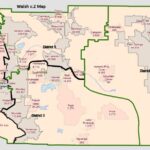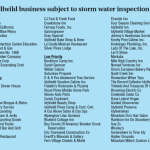In anticipation of a possible declaration of Water Conservation Stage 3, Idyllwild Water District Rules and Regulations Committee recommended revisions to its water policy ordinance last week. The proposed changes will be reviewed at the September board of directors meeting.
As the meeting began, General Manager Tom Lynch told committee members, Directors John Cook and Warren Monroe, that “… we have to be prepared if we have to move into Stage 3. If we can’t keep the [groundwater] level of the wells at Foster Lake, it’s time to trigger Stage 3 … we want [proposed] Ordinance 64 in place if we need to pull the trigger.”
IWD has been in Stage 2 since September 2013.
If Stage 3 is needed, Lynch said the cost of production would increase and the risk of the tanks being less than full is greater. For example, a busy weekend could draw more water, but the wells may need more time to re-supply that quantity.
Currently, three of IWD’s four criteria for establishing Stage 3 have been met. The groundwater level of the Foster Lake wells still remains above 50 feet, despite an empty Foster Lake, and that is the only criterion not signaling a move to Stage 3, according to Lynch.
The new policy does not enumerate the criteria for each stage 1 through 3. However, it does state that no stage may be declared if Foster Lake is full and the downtown well levels are no deeper than 15 feet.
One general recommendation from the committee was adding a section specifying how the general manager can enforcement the limitations for each stage; for instance, warnings and fines.
Most of the changes address implementing Stage 1 (voluntary compliance) and Stage 2 (mandatory compliance). For example, added to Stage 1 is an explanation of preventing irrigation water runoff. The new language states, “ … such that water flows onto adjacent property, non-irrigated areas, private and public walkways, roadways, parking lots, or structures.”
Stage 2 changes include limiting irrigation of outdoor plants and gardens to 6 p.m. through 8 a.m. two days per week. Another change will limit outdoor irrigation to during and within 48 hours following measurable precipitation.
In Stage 3, prohibitions are using potable water for outdoor irrigation, landscaping or dust control, and minimizing its use for construction purposes.
“Based on present consumption, some additional conservation is appropriate,” Lynch stated. “It may be the only way, in additional stages, that our capacity can provide sufficient water, maintain the tanks and run wells efficiently. The wells are being taxed now.”
This year from January through August, IWD consumption has been 50.7 million gallons, compared to 56.9 million for the same period in 2014 and 63.9 million gallons in 2013. Customers have reduced consumption more than 20 percent in two years.
In response to Monroe’s question about whether IWD is calculating its costs for producing water under different conditions, Lynch responded that the current estimate to produce a cubic foot of water (about 7.5 gallons) is between 8 and 9 cents.
As the drought continues, well levels will fall further. Consequently, the cost will increase to between 10 and 12 cents per cubic foot (or about 1.3 to 1.6 cents per gallon) because the well pumps will work harder (because of greater depth) and longer.
Currently, IWD rates for Stage 3 are about 10 cents per cubic foot, except for tier 4 usage, when it charges 21 cents per cubic foot.
Southern California Edison is working with IWD to develop recommendations for reducing electric costs, according to Lynch.









